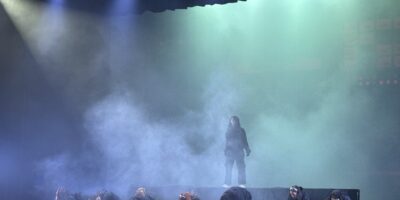(Note: this article contains major spoilers for all five books of the series. Proceed with caution!)
In a world where there are more religions than morally sane characters, it is no surprise that there are a few apocalypse-cancelling hero prophecies. The most popular of these is the story of Azor Ahai, who, in short, is the fiery messiah for the followers of R’hllor, appointed to fight against an unexplained darkness that covered the world many many years ago. As a hero, he was tasked to forge the sword that would become the famous Lightbringer, and after twice failing to temper it, thrust its blade into the heart of his wife, Nissa Nissa, in a typical “morality requires sacrifice” fable fashion. He then helped to vanquish the evil darkness — which some believe to be reference to the Others that lived during the Long Night .
His story then tells of another champion to be sent by R’hllor: Azor Ahai reborn, prophesied to return after a long summer, when yet again an evil cold force of darkness would threaten the world… a very familiar setting, all in all. The reborn saviour is foretold to be born amidst salt and smoke, wielding Lightbringer, and very likely to be of the Blood of the Dragon.
The first and most obvious of candidates is Melisandre’s personal fave, Stannis Baratheon, the First of Name, King of the Andals, the Rhoynar, and the First Men, the rightful King of Westeros. Well, depending on who you ask. He fits almost all of the criteria implied for the reborn saviour: he was (re)born amidst salt and smoke on the volcanic island of Dragonstone (which, coincidentally, he also owns by rights), and has a Targaryen grandmother on his father’s side, Rhaelle. His own self-proclaimed “Lightbringer” also seems to be convincing evidence, but also might be the biggest clue against his viability— while the sword very clearly appears aflame, it is also said to bear no heat. Both Salladhor Saan and Maester Aemon make references to the fact, with a heatless flame bearing nothing but ill omens. Perhaps this tiny error comes about the fact that Stannis tempered his sword in the flaming statue of the Maiden from the Faith of the Seven, not his own wife, Selyse.
An interesting twist to help rectify Stannis’ claim is the theory that perhaps Lightbringer is not, in fact, a literal sword, but a metaphor for a far more powerful weapon: the Night’s Watch. Their oath of being “the sword in the darkness” and “the fire that burns against the cold, the light that brings the dawn” does match the lore very nicely. The sacrifice of Nissa Nissa to create Lightbringer could also be drawn as a parallel to the vow that the Night’s Watch must take no wives. With Stannis’ current position at the wall, it may just be time for him to wield his ‘sword’ against the forces of darkness to come.
Of course, this also leaves another popular candidate for Azor Ahai reborn: Jon Snow, who, as discussed in an earlier issue, is popularly believed to be the child of Lyanna Stark and Rhaegar Targaryen, thus coming directly from the line of dragons. In A Dance with Dragons, Melisandre reflects that whenever she asks for a glimpse of the Lord’s chosen, R’hllor shows her only Snow— and yes, capital included. There is a very nice visual parallel between snow and ash to be made here, but perhaps more convincing is Jon’s sense of duty leading him to abandon his own Nissa Nissa, the wildling Ygritte, to return to the Night’s Watch. His recent election as the 998th Lord Commander of the Night’s Watch puts him in a very good position to wield the Watch as his own Lightbringer, although the multiple stab wounds might cause a few issues.
Daenerys is also a popular candidate for the position— Maester Aemon once again provides wisdom in the fact that Dragons are neither male nor female, meaning that there is no reason that the promised saviour could not be a woman. Dragonstone was her literal birthplace, while Drogo’s funeral pyre served as a suitably fiery place of rebirth. Also the dragons. Who better to serve as a fiery messiah than the Mother of Dragons?
An interesting dark horse in the theory is Victarion Greyjoy. While at first this seems impossible and bizarre, there are irrefutable similarities between the R’hllor and the Drowned God, both featuring a monotheist religion with a central evil deity, legends of saviours that fought against great evils, rebirth and human sacrifice (be it through drowning or getting burnt alive… I’ll take a beheading, thanks). Victarion, tasked to take Daenerys as Euron’s bride and planning to take Dany for himself, falls into quite a peculiar series of events on his shipride over. After rescuing a red priest from the water, Moqorro, he has a potentially mortal hand wound treated with red magic, leaving his flesh appearing burnt and smoking. Moqorro tells him of the wondrous future for Victarion that he sees in his flames, and eventually converts the Greyjoy to respect the Red God — though interestingly, while still honouring the Drowned God. Victarion clearly satisfied both aspects of the ‘salt and smoke’ detail, and as an added bonus, beat his own wife to death, although, that was after his brother Euron impregnated her, and he didn’t get a flaming sword out of the deal.
There are much more complexities to this prophecy in the way that it overlaps with other foretold heroes— there is a vaguely referenced “Prince that was Promised”, which may or may not be merely another incarnation of Azor Ahai. In addition, there is Daenerys’ vision in the House of the Undying that promised that “the dragon has three heads”, with Daenerys clearly being one. Is it possible that this unified three-headed dragon is the entire entity of Azor Ahai to save the world from the terrors to come? It seems the only way we’ll know is when the rest of the books are published… which, for the love of R’hllor, I hope is soon.




Leave a Reply